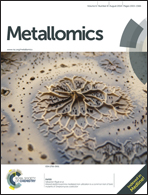Transformed yeast (Schizosaccharomyces pombe) overexpressing rice Tau class glutathione S-transferase (OsGSTU30 and OsGSTU41) shows enhanced resistance to hexavalent chromium†
Abstract
Extensive use of hexavalent chromium [Cr(VI)] in leather tanning, stainless-steel production, wood preservatives and electroplating industries has resulted in widespread environmental pollution and poses a serious threat to human health. A plant's response to Cr(VI) stress results in growth inhibition and toxicity leading to changes in components of antioxidant systems. In a previous study, we observed that a large number of glutathione S-transferase (GST) genes were up-regulated under Cr(VI) stress in rice. In this study, two rice root-specific Tau class GST genes (OsGSTU30 and OsGSTU41) were introduced into yeast (Schizosaccharomyces pombe). Transformed yeast cells overexpressing OsGSTU30 and OsGSTU41 had normal growth, but had much higher levels of GST activities and showed enhanced resistance to Cr(VI) as compared to control cells (transformed with empty vector). Also, a higher accumulation of chromium was found in the transformed yeast cells as compared to the control cells. Manipulation of glutathione biosynthesis by exogenous application of buthionine sulfoximine abolishes the protective effect of OsGSTs against Cr(VI) stress. These results suggest that Tau class OsGSTs play a significant role in detoxification of Cr(VI), probably by chelating and sequestrating glutathione–Cr(VI) complexes into vacuoles.


 Please wait while we load your content...
Please wait while we load your content...